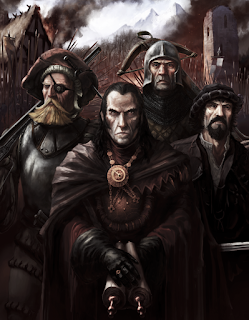Balance: Encounters
The last time I talked about balance with regards to character classes, I found myself outspoken on several points. Well buckle up, because we're going back in to talk about balancing encounters.
Anyone who is afraid to place a lich in their beginner's dungeon should have a look at Tomb of the Serpent Kings
- art by David A. Trampier -
Challenge rating. If you've ever DM'd a 5E campaign you know the struggle of getting the CR for any combat encounter just right. Too low and the party will steamroll the enemies without spending any resources. Too high and you risk a TPK, ruining the beautifully crafted arcs for each PC. 5E's mechanics and inclusion of CR in the monster stat blocks creates this unique conundrum. As for myself, I have freely dealt my players magic items and weapons from Session One, and now I feel like I can throw any CR encounter at them and they will go hard every time, and nobody leaves the table disappointed. The threat of death is very real, but they have plenty of resources to prevent it. However, the very existence of CR in 5E creates the expectation (for both players and DMs) that encounters will be balanced. By balanced, I mean to say that players can confidently face whatever foe is placed in their way, knowing that they are capable of defeating it. In other words, balanced encounters in 5E means that victory is assured, though theatrics may temporarily convey the opposite. This is another symptom of 5E's narrative focus, and while that kind of game is engaging at times, I personally find the unpredictability of OSR games to be far more appealing.
Consider a group of adventurers on their first outing. The happen upon a series of caves that give way to crypts and ancient ruins as they delve ever deeper. What expectations should they have as they proceed? If they expect to be capable enough to handle every monstrous threat within the dungeon, they will probably proceed with reckless abandon into the depths, engaging every enemy they meet in bloody combat. They will leave a trail of bodies as they carve a path through the dungeon, and maybe even go out of their way to eliminate every existing creature in the dungeon, you know, for experience. This course of action will inevitably lead to death for the OSR party. This is because the average OSR dungeon cares little for what level the PCs are. The Caves of Chaos in The Keep on the Borderlands are diversely populated; kobolds, ogres, minotaurs, and even gargoyles lurk in the various nooks and crannies of the caves. Mind you, this module is recommended for players who are level 1-3. Players new to the genre quickly learn that squaring off against every enemy in the caves is a poor strategy. They will learn to proceed with caution, avoiding combat either through stealth or trickery. Are the Caves of Chaos balanced for the intended audience? I would say no. The monsters the party will face can easily overpower the PCs, and they have hit dice to spare. Despite not being balanced, are the encounters fair? Absolutely.
C'mon guys! The DM wouldn't put a dragon here unless we could kill it!
- art by David C. Sutherland III -
Game mechanics also play into fairness. Morale is a prominent feature of AD&D and many OSR games. This means that few enemies (or hirelings) will stick around for a fight to the death when the fight is not going their way. A few well-placed arrows into the leader of a band of orcs may cause the rest of them to flee. Even the monster descriptions in the original Monster Manual are incredibly detailed, and outline the monster's behavior so the DM won't play every creature like a murderous puppeteer. Some creatures simply inhabit a role in the environment, and outside of that role aren't very interested in adventurers. Many of the more deadly ones have specific weaknesses that, once discovered and exploited, make combat much easier (fire vs. a black pudding being a classic example). Eavesdropping on chatty dungeon-dwelling humanoids or soliciting an eminent sage for advice are just a few resources at the party's disposal for dealing with creatures that could easily overpower them.
The line between balance and fairness may seem arbitrary. But when we view balance through the lens of what games strive for in a modern setting (guaranteed success with the illusion of difficulty) fairness takes on a new meaning. A game that is not balanced, but fair creates reasonable expectations for the players, then allows them to measure risk and decide their own fate by their actions. A game that is balanced is rarely fair, because the conditions for failure are so extreme that player choices are often meaningless in the grand scheme of things.
While I hope my personal philosophies are clear enough in this matter, I'll make the disclaimer once again that these conditions vary from table to table. A DM could very well implement unbalanced encounters in 5E, or have a narrative-focused campaign in 1E where death is unlikely if it impedes the story progression. But from a design perspective, 5E creates an expectation for balance, while old-school TTRPGs do not. Going against the game design can be difficult to do, and have unintended consequences along the way. That's why my 5E players are safe... for now.




Comments
Post a Comment